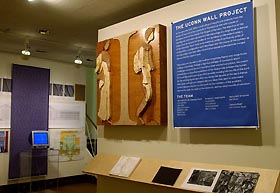|
This is an archived article.
For the latest news, go to the Advance
Homepage
For more archives, go to the Advance Archive/Search Page. |
||
|
Friezes
Planned for Heart of Campus
Are Metaphor for Community By Elizabeth Omara-Otunnu Crisscrossing the bustling hub of the Storrs campus, students and faculty wend their way to class, to the Homer Babbidge Library, to the Student Union, and to department offices, in a constant ebb and flow. Soon they will be joined by others, but the newcomers will never reach their destinations. Instead, they will be cast in a perpetual quest for their goals.
The figures about to become part of the University community are a couple of dozen sculptures to be installed in friezes running across the front of additions planned for two matching buildings at the east end of the Student Union Mall: Gentry Building, which houses the Neag School of Education, and the Undergraduate Center, formerly the Business School. An element in the original architectural concept by Svigals + Partners for the renovation of these buildings, the three stories of friezes were designed over the summer by a team comprising faculty and students from the School of Fine Arts working in collaboration with the architects. Svigals + Partners, who participated in the campus master planning process in 1996 and were also the architects for the new agricultural-b iotechnology building, incorporate sculptural elements in most of their architectural designs. "It was a logical extension of our work to do this," says Barry Svigals, managing partner, "and the proposal was well received by the University." An installation now on display as part of the 37th annual art department faculty exhibition at the William Benton Museum of Art conveys the ideas and the creative process at the core of the UConn Wall Project. Mirroring Life "The figures will mirror the life of people inside and outside the building," adds Svigals. Interlocking with these figures and on the same scale will be a series of letterforms, distilled from the 12 unique letters that comprise the name University of Connecticut. The words, some mundane, some inspirational, "represent the words, ideals, and concepts that people at the University work with and toward on a daily basis," says Hoyt. A few of the words being considered for the frieze are trust, unity, voice, and conscience. Some of the letterforms are only partial and are completed by the figures. Team Approach "As the walking figures work their way across the facades of the two buildings, they must confront and complete the very ideas they seek to understand," reads an explanation that is part of the exhibit. "Letters become figures become words, as the members of the academic community seek the heart of the university and the many rewards of education." "The friezes are an interesting interlocking of architecture, technique, and philosophy," says Lorraine Aronson, vice president for financial planning and management. "They should become a very nice centerpiece for the University." The figures are now being sculpted in clay, from which the molds will be made. The final panels will be cast in fiberglass, which is less expensive and more durable than the stone it will resemble. Sculptor Robert Shure, owner of Skylight Studios, will fabricate the panels. The building additions are currently under construction and the friezes are expected to be installed in the spring. Members of the design committee were Erin Anfinson, an MFA student; John Bent, an undergraduate student; and art and art history faculty members Hoyt; Cora Lynn Deibler; Edvin Yegir; and Mark Zurolo. |

